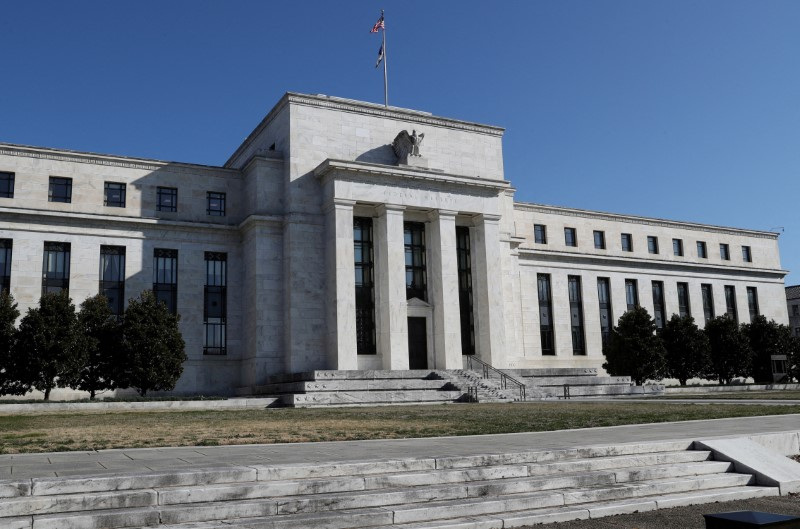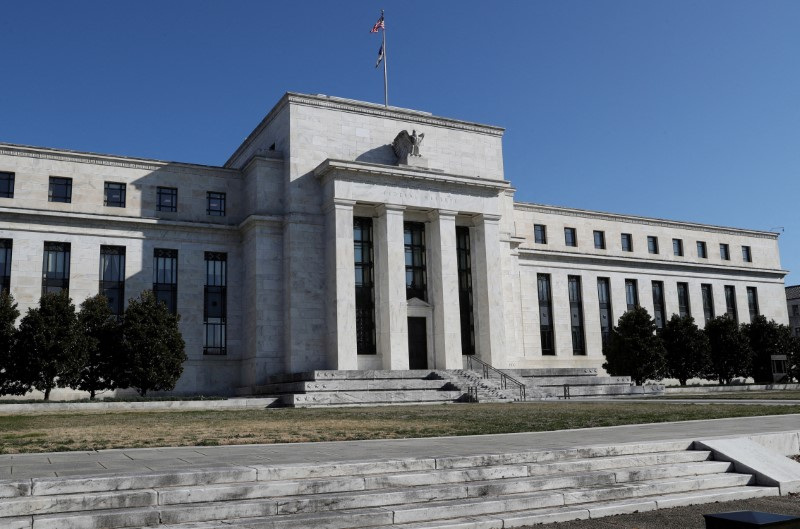Economy
Column-Fed can slash rates and still be ‘higher for longer’: McGeever


© Reuters. FILE PHOTO: Federal Reserve Board building on Constitution Avenue is pictured in Washington, U.S., March 19, 2019. REUTERS/Leah Millis/File Photo
By Jamie McGeever
ORLANDO, Florida (Reuters) – The Federal Reserve could comfortably lop a percentage point off its policy rate next year without changing its mantra of ‘higher for longer’ – what seems a contradiction is easily resolved.
Given the Fed’s best estimate of a ‘neutral’ policy rate that neither stimulates nor slows growth or inflation is 2.5%, anything above that is essentially still bearing down on the economy. Policy remains ‘restrictive,’ in central bank parlance.
The Fed’s official fed funds rate now is the mid-point of the 5.25-5.50% range, and rates futures market pricing has it being lowered to around 4.00% by the end of next year.
While markets are already nervy that expecting cuts of that magnitude may be jumping the gun given a persistent ‘higher for longer’ mantra and lack of recession, it would still leave the policy rate some 150 basis points above neutral.
At 4.0%, rates would still be far higher than they were before the tightening cycle began in March 2022 and around a full point higher than what markets assumed the end-2024 rate would be just a year ago.
A fed funds rate of 4% would still be higher than the peak of the last cycle, considerably higher than where it has been for most of the last 20 years and, in real terms, still the highest in several years.
And of course, as inflation ebbs further from here without any policy rate cut, the real fed funds rate is rising.
And if prevailing core PCE inflation rates of 3.5% were to fall to target, then the Fed could comfortably cut 150 bps without ever reducing the real policy rate – again, ‘higher for longer’ applies.
“That is probably the base case now in terms of likelihood,” says Alex Etra, senior macro strategist at Exante Data and a former New York Fed analyst.
“‘Higher for longer’ is always a function of your base of comparison – it is possible the Fed could still cut interest rates and still have higher rates than previously experienced or higher than had previously been anticipated,” he adds.
HIGHLY RESTRICTIVE
A trend has emerged over the last 30 years or so – the Fed is keeping its policy rate at the cycle peak for longer than it used to. If the first rate cut comes in May, as futures market pricing indicates, the 10-month gap since the last hike will be the second longest since at least the 1950s.
That could fairly be seen as keeping rates ‘higher for longer,’ in nominal and basic timeline terms. But the ‘higher for longer’ line that Fed officials drove for much this year is evaporating from market thinking.
Fed Governor Christopher Waller’s hints on Nov. 28 that rates could be cut sooner than previously anticipated were significant. Fed Chair Jerome Powell had the perfect opportunity to push back against that view in prepared remarks and a question and answer session on Dec. 1, but chose not to.
Bond yields have slumped, implied interest rates have cratered, and the dollar has softened up.
Financial conditions have loosened considerably, at least as far as market-based indicators go. The Chicago Fed U.S. financial conditions index (FCI) is its lowest since February last year, and Goldman Sachs’s FCI is the lowest in four months.
These indexes are compiled of financial market inputs like money market rates, equity prices, credit spreads, the dollar exchange rate, and long- and short-dated yields.
But if financial conditions for Wall Street have loosened over the past year, financial conditions for Main Street have tightened.
A range of ‘Main Street’ indicators like the Fed’s Senior Loan Officer Opinion Survey show that the Fed’s 525 bps of rate hikes since March last year are biting – bank lending standards are tightening, loan growth is turning negative, and delinquencies and bankruptcies are increasing.
Ultimately though, the most important financial conditions indicator is the Fed’s policy rate, and whether it is accommodative, neutral, or restrictive for the economy at large.
The Federal Open Market Committee next week updates its Summary of Economic Projections, including the median estimate for the longer-run policy rate which has been 2.5% for almost five years, save for a brief dip to 2.4% in early 2022.
Assuming annual inflation returns to the Fed’s 2% target, this implies a real neutral interest rate – the nebulous, holy grail of central bankers known as ‘r-star’ – of 0.5%.
New York Fed President John Williams said last week that some models suggest monetary policy right now is the most restrictive in a quarter century.
“I expect it will be appropriate to maintain a restrictive stance for quite some time … to bring inflation back to our 2% longer-run goal on a sustained basis,” he said last week.
Room to cut rates, and stay ‘higher for longer.’
(The opinions expressed here are those of the author, a columnist for Reuters.)
(By Jamie McGeever; Editing by Andrea Ricci)
Economy
Russian central bank says it needs months to make sure CPI falling before rate cuts -RBC


© Reuters. Russian Central Bank Governor Elvira Nabiullina attends a news conference in Moscow, Russia June 14, 2019. REUTERS/Shamil Zhumatov/File Photo
MOSCOW (Reuters) – Russia’s central bank will need two to three months to make sure that inflation is steadily declining before taking any decision on interest rate cuts, the bank’s governor Elvira Nabiullina told RBC media on Sunday.
The central bank raised its key interest rate by 100 basis points to 16% earlier in December, hiking for the fifth consecutive meeting in response to stubborn inflation, and suggested that its tightening cycle was nearly over.
Nabiullina said it was not yet clear when exactly the regulator would start cutting rates, however.
“We really need to make sure that inflation is steadily decreasing, that these are not one-off factors that can affect the rate of price growth in a particular month,” she said.
Nabiullina said the bank was taking into account a wide range of indicators but primarily those that “characterize the stability of inflation”.
“This will take two or three months or more – it depends on how much the wide range of indicators that characterize sustainable inflation declines,” she said.
The bank will next convene to set its benchmark rate on Feb. 16.
The governor also said the bank should have started monetary policy tightening earlier than in July, when it embarked on the rate-hiking cycle.
Economy
China identifies second set of projects in $140 billion spending plan


© Reuters. FILE PHOTO: Workers walk past an under-construction area with completed office towers in the background, in Shenzhen’s Qianhai new district, Guangdong province, China August 25, 2023. REUTERS/David Kirton/File Photo
SHANGHAI (Reuters) – China’s top planning body said on Saturday it had identified a second batch of public investment projects, including flood control and disaster relief programmes, under a bond issuance and investment plan announced in October to boost the economy.
With the latest tranche, China has now earmarked more than 800 billion yuan of its 1 trillion yuan ($140 billion) in additional government bond issuance in the fourth quarter, as it focuses on fiscal steps to shore up the flagging economy.
The National Development and Reform Commission (NDRC) said in a statement on Saturday it had identified 9,600 projects with planned investment of more than 560 billion yuan.
China’s economy, the world’s second largest, is struggling to regain its footing post-COVID-19 as policymakers grapple with tepid consumer demand, weak exports, falling foreign investment and a deepening real estate crisis.
The 1 trillion yuan in additional bond issuance will widen China’s 2023 budget deficit ratio to around 3.8 percent from 3 percent, the state-run Xinhua news agency has said.
“Construction of the projects will improve China’s flood control system, emergency response mechanism and disaster relief capabilities, and better protect people’s lives and property, so it is very significant,” the NDRC said.
The agency said it will coordinate with other government bodies to make sure that funds are allocated speedily for investment and that high standards of quality are maintained in project construction.
($1 = 7.1315 renminbi)
Economy
Russian central bank says it needs months to make sure CPI falling before rate cuts -RBC


© Reuters. Russian Central Bank Governor Elvira Nabiullina attends a news conference in Moscow, Russia June 14, 2019. REUTERS/Shamil Zhumatov/File Photo
MOSCOW (Reuters) – Russia’s central bank will need two to three months to make sure that inflation is steadily declining before taking any decision on interest rate cuts, the bank’s governor Elvira Nabiullina told RBC media on Sunday.
The central bank raised its key interest rate by 100 basis points to 16% earlier in December, hiking for the fifth consecutive meeting in response to stubborn inflation, and suggested that its tightening cycle was nearly over.
Nabiullina said it was not yet clear when exactly the regulator would start cutting rates, however.
“We really need to make sure that inflation is steadily decreasing, that these are not one-off factors that can affect the rate of price growth in a particular month,” she said.
Nabiullina said the bank was taking into account a wide range of indicators but primarily those that “characterize the stability of inflation”.
“This will take two or three months or more – it depends on how much the wide range of indicators that characterize sustainable inflation declines,” she said.
The bank will next convene to set its benchmark rate on Feb. 16.
The governor also said the bank should have started monetary policy tightening earlier than in July, when it embarked on the rate-hiking cycle.

 Forex3 years ago
Forex3 years agoForex Today: the dollar is gaining strength amid gloomy sentiment at the start of the Fed’s week

 Forex3 years ago
Forex3 years agoUnbiased review of Pocket Option broker

 Forex3 years ago
Forex3 years agoDollar to pound sterling exchange rate today: Pound plummeted to its lowest since 1985

 Forex3 years ago
Forex3 years agoHow is the Australian dollar doing today?

 Cryptocurrency3 years ago
Cryptocurrency3 years agoWhat happened in the crypto market – current events today

 World3 years ago
World3 years agoWhy are modern video games an art form?

 Commodities3 years ago
Commodities3 years agoCopper continues to fall in price on expectations of lower demand in China

 Economy3 years ago
Economy3 years agoCrude oil tankers double in price due to EU anti-Russian sanctions

























